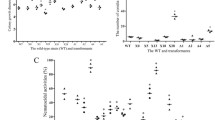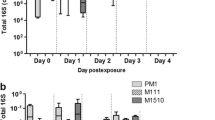Abstract
Pseudogymnoascus destructans (Pd) is the etiologic agent of bat White-nose syndrome, a disease that has caused the unprecedented reduction in the hibernating bat populations across eastern North America. The Pd pathogenesis appears to be a complex adaptation of fungus in its abiotic (caves and mines) and biotic (bats) environments. There is a general lack of experimental tools for the study of Pd biology. We described the successful expression of codon-optimized synthetic green fluorescent protein sGFP in Pd. The sGFP(S65T) gene was first fused in frame with the Aspergillus nidulans promoter in the tumor-inducing plasmid pRF-HUE, and the resulting plasmid pHUE-sGFP(S65T) was transformed into Pd by Agrobacterium tumefaciens-mediated transformation system. The integration of sGFP(S65T) in Pd genome was analyzed by PCR, and single integration frequency of approximately 66% was confirmed by Southern hybridization. Fluorescent microscopy and flow cytometric analyses of two randomly selected transformants with single integration revealed high expression of sGFP in both spores and hyphal structures. The biology of mutants as judged by sporulation, growth rate, and urease production was not altered indicating sGFP is not toxic to Pd. Thus, we have generated a valuable tool that will facilitate the elucidation of Pd biology, ecology, and pathogenicity in real time.






Similar content being viewed by others
References
Blehert DS, Hicks AC, Behr M, Meteyer CU, Berlowski-Zier BM, Buckles EL, Coleman JT, Darling SR, Gargas A, Niver R, et al. Bat white-nose syndrome: an emerging fungal pathogen? Science. 2009;323(5911):227.
Chaturvedi V, Springer DJ, Behr MJ, Ramani R, Li X, Peck MK, Ren P, Bopp DJ, Wood B, Samsonoff WA, et al. Morphological and molecular characterizations of psychrophilic fungus Geomyces destructans from New York bats with White Nose Syndrome (WNS). PLoS ONE. 2010;5(5):e10783.
Frick WF, Pollock JF, Hicks AC, Langwig KE, Reynolds DS, Turner GG, Butchkoski CM, Kunz TH. An emerging disease causes regional population collapse of a common North American bat species. Science. 2010;329(5992):679–82.
Blehert DS. Fungal disease and the developing story of bat white-nose syndrome. PLoS Pathog. 2012;8(7):e1002779.
Rajkumar SS, Li X, Rudd RJ, Okoniewski JC, Xu J, Chaturvedi S, Chaturvedi V. Clonal genotype of Geomyces destructans among bats with White Nose Syndrome, New York, USA. Emerg Infect Dis. 2011;17(7):1273–6.
Ren P, Haman KH, Last LA, Rajkumar SS, Keel MK, Chaturvedi V. Clonal spread of Geomyces destructans among bats, midwestern and southern United States. Emerg Infect Dis. 2012;18(5):883–5.
Lindner DL, Gargas A, Lorch JM, Banik MT, Glaeser J, Kunz TH, Blehert DS. DNA-based detection of the fungal pathogen Geomyces destructans in soils from bat hibernacula. Mycologia. 2011;103(2):241–6.
Zhang T, Victor TR, Rajkumar SS, Li X, Okoniewski JC, Hicks AC, Davis AD, Broussard K, LaDeau SL, Chaturvedi S, et al. Mycobiome of the bat white nose syndrome affected caves and mines reveals diversity of fungi and local adaptation by the fungal pathogen Pseudogymnoascus (Geomyces) destructans. PLoS ONE. 2014;9(9):e108714.
Dhandayuthapani S, Via LE, Thomas CA, Horowitz PM, Deretic D, Deretic V. Green fluorescent protein as a marker for gene expression and cell biology of mycobacterial interactions with macrophages. Mol Microbiol. 1995;17(5):901–12.
Valdivia RH, Hromockyj AE, Monack D, Ramakrishnan L, Falkow S. Applications for green fluorescent protein (GFP) in the study of host-pathogen interactions. Gene. 1996;173(1 Spec No):47–52.
Ikawa M, Yamada S, Nakanishi T, Okabe M. Green fluorescent protein (GFP) as a vital marker in mammals. Curr Top Dev Biol. 1999;44:1–20.
Green RA, Audhya A, Pozniakovsky A, Dammermann A, Pemble H, Monen J, Portier N, Hyman A, Desai A, Oegema K. Expression and imaging of fluorescent proteins in the C. elegans gonad and early embryo. Methods Cell Biol. 2008;85:179–218.
Tsien RY. The green fluorescent protein. Annu Rev Biochem. 1998;67:509–44.
Gerami-Nejad M, Berman J, Gale CA. Cassettes for PCR-mediated construction of green, yellow, and cyan fluorescent protein fusions in Candida albicans. Yeast. 2001;18(9):859–64.
Staab JF, Bahn YS, Sundstrom P. Integrative, multifunctional plasmids for hypha-specific or constitutive expression of green fluorescent protein in Candida albicans. Microbiology. 2003;149(Pt 10):2977–86.
Spellig T, Bottin A, Kahmann R. Green fluorescent protein (GFP) as a new vital marker in the phytopathogenic fungus Ustilago maydis. Mol Gen Genet. 1996;252(5):503–9.
Dumas B, Centis S, Sarrazin N, Esquerre-Tugaye MT. Use of green fluorescent protein to detect expression of an endopolygalacturonase gene of Colletotrichum lindemuthianum during bean infection. Appl Environ Microbiol. 1999;65(4):1769–71.
Robinson M, Sharon A. Transformation of the bioherbicide Colletotrichum gloeosporioides f. sp. Aeschynomene By electroporation of germinated conidia. Curr Genet. 1999;36(1–2):98–104.
Flowers JL, Vaillancourt LJ. Parameters affecting the efficiency of Agrobacterium tumefaciens-mediated transformation of Colletotrichum graminicola. Curr Genet. 2005;48(6):380–8.
Zeilinger S, Galhaup C, Payer K, Woo SL, Mach RL, Fekete C, Lorito M, Kubicek CP. Chitinase gene expression during mycoparasitic interaction of Trichoderma harzianum with its host. Fungal Genet Biol. 1999;26(2):131–40.
Fernández-Abalos JM, Fox H, Pitt C, Wells B, Doonan J. Plant-adapted green fluorescent protein is a versatile vital reporter for gene expression, protein localization and mitosis in the filamentous fungus, Aspergillus nidulans. Mol Microbiol. 1998;27(1):121–30.
Liu ZM, Kolattukudy PE. Early expression of the calmodulin gene, which precedes appressorium formation in Magnaporthe grisea, is inhibited by self-inhibitors and requires surface attachment. J Bacteriol. 1999;181(11):3571–7.
Kershaw MJ, Wakley G, Talbot NJ. Complementation of the mpg1 mutant phenotype in Magnaporthe grisea reveals functional relationships between fungal hydrophobins. EMBO J. 1998;17(14):3838–49.
van West P, Reid B, Campbell TA, Sandrock RW, Fry WE, Kamoun S, Gow NA. Green fluorescent protein (GFP) as a reporter gene for the plant pathogenic oomycete Phytophthora palmivora. FEMS Microbiol Lett. 1999;178(1):71–80.
Hammond TM, Xiao H, Rehard DG, Boone EC, Perdue TD, Pukkila PJ, Shiu PK. Fluorescent and bimolecular-fluorescent protein tagging of genes at their native loci in Neurospora crassa using specialized double-joint PCR plasmids. Fungal Genet Biol. 2011;48(9):866–73.
Delgado-Alvarez DL, Callejas-Negrete OA, Gomez N, Freitag M, Roberson RW, Smith LG, Mourino-Perez RR. Visualization of F-actin localization and dynamics with live cell markers in Neurospora crassa. Fungal Genet Biol. 2010;47(7):573–86.
Heim R, Cubitt AB, Tsien RY. Improved green fluorescence. Nature. 1995;373(6516):663–4.
Lorang JM, Tuori RP, Martinez JP, Sawyer TL, Redman RS, Rollins JA, Wolpert TJ, Johnson KB, Rodriguez RJ, Dickman MB, et al. Green fluorescent protein is lighting up fungal biology. Appl Environ Microbiol. 2001;67(5):1987–94.
Vinck A, de Bekker C, Ossin A, Ohm RA, de Vries RP, Wosten HA. Heterogenic expression of genes encoding secreted proteins at the periphery of Aspergillus niger colonies. Environ Microbiol. 2011;13(1):216–25.
Zhang T, Ren P, Chaturvedi V, Chaturvedi S. Development of an Agrobacterium-mediated transformation system for the cold-adapted fungi Pseudogymnoascus destructans and P. pannorum. Fungal Genet Biol. 2015;81:73–81.
Maorb R, Puyeskyc M, Horwitzc BA, Sharon A. Use of green fluorescent protein (GFP) for studying development and fungal-plant interaction in Cochliobolus heterostrophus. Mycol Res. 1998;102(4):491–6.
Cormack BP, Bertram G, Egerton M, Gow NA, Falkow S, Brown AJ. Yeast-enhanced green fluorescent protein (yEGFP): a reporter of gene expression in Candida albicans. Microbiology. 1997;143(Pt 2):303–11.
Chiu W, Niwa Y, Zeng W, Hirano T, Kobayashi H, Sheen J. Engineered GFP as a vital reporter in plants. Curr Biol. 1996;6(3):325–30.
Haas J, Park EC, Seed B. Codon usage limitation in the expression of HIV-1 envelope glycoprotein. Curr Biol. 1996;6(3):315–24.
Andrie RM, Martinez JP, Ciuffetti LM. Development of ToxA and ToxB promoter-driven fluorescent protein expression vectors for use in filamentous ascomycetes. Mycologia. 2005;97(5):1152–61.
Park SY, Jeong MH, Wang HY, Kim JA, Yu NH, Kim S, Cheong YH, Kang S, Lee YH, Hur JS. Agrobacterium tumefaciens-mediated transformation of the lichen fungus, Umbilicaria muehlenbergii. PLoS ONE. 2013;8(12):e83896.
Wu D, Navet N, Liu Y, Uchida J, Tian M. Establishment of a simple and efficient Agrobacterium-mediated transformation system for Phytophthora palmivora. BMC Microbiol. 2016;16(1):204.
van Attikum H, Bundock P, Hooykaas PJ. Non-homologous end-joining proteins are required for Agrobacterium T-DNA integration. EMBO J. 2001;20(22):6550–8.
Visser M, Gordon TR, Wingfield BD, Wingfield MJ, Viljoen A. Transformation of Fusarium oxysporum f. sp. cubense, causal agent of Fusarium wilt of banana, with the green fluorescent protein (GFP) gene. Australas Plant Pathol. 2004;33:69–75.
Rouwendal GJ, Mendes O, Wolbert EJ, Douwe de Boer A. Enhanced expression in tobacco of the gene encoding green fluorescent protein by modification of its codon usage. Plant Mol Biol. 1997;33(6):989–99.
Vanden Wymelenberg AJ, Cullen D, Spear RN, Schoenike B, Andrews JH. Expression of green fluorescent protein in Aureobasidium pullulans and quantification of the fungus on leaf surfaces. Biotechniques. 1997;23(4):686–90.
Horowitz S, Freeman S, Sharon A. Use of green fluorescent protein-transgenic strains to study pathogenic and nonpathogenic lifestyles in Colletotrichum acutatum. Phytopathology. 2002;92(7):743–9.
Chen N, Hsiang T, Goodwin PH. Use of green fluorescent protein to quantify the growth of Colletotrichum during infection of tobacco. J Microbiol Methods. 2003;53(1):113–22.
Rajasekaran K, Cary JW, Cotty PJ, Cleveland TE. Development of a GFP-expressing Aspergillus flavus strain to study fungal invasion, colonization, and resistance in cottonseed. Mycopathologia. 2008;165(2):89–97.
Cryan PM, Meteyer CU, Blehert DS, Lorch JM, Reeder DM, Turner GG, Webb J, Behr M, Verant M, Russell RE, et al. Electrolyte depletion in white-nose syndrome bats. J Wildl Dis. 2013;49(2):398–402.
Errampalli D, Leung K, Cassidy MB, Kostrzynska M, Blears M, Lee H, Trevors JT. Applications of the green fluorescent protein as a molecular marker in environmental microorganisms. J Microbiol Methods. 1999;35(3):187–99.
Orr KA, Knudsen GR. Use of green fluorescent protein and image analysis to quantify proliferation of Trichoderma harzianum in nonsterile soil. Phytopathology. 2004;94(12):1383–9.
Bae YS, Knudsen GR. Cotransformation of Trichoderma harzianum with beta-glucuronidase and green fluorescent protein genes provides a useful tool for monitoring fungal growth and activity in natural soils. Appl Environ Microbiol. 2000;66(2):810–5.
Frandsen RJ, Andersson JA, Kristensen MB, Giese H. Efficient four fragment cloning for the construction of vectors for targeted gene replacement in filamentous fungi. BMC Mol Biol. 2008;9:70.
Acknowledgements
This study was partly supported with funds from the National Science Foundation (16-0039-01). Dr. Rasmus JN Frandsen (Frederiksberg, Denmark) is thanked for the generous gift of plasmid pRF-HUE. We also thank Renjie Song for assistance with flow cytometry.
Author information
Authors and Affiliations
Corresponding authors
Additional information
Handling Editor: J.-P. Bouchara.
Electronic supplementary material
Below is the link to the electronic supplementary material.
11046_2018_285_MOESM1_ESM.docx
Supplementary Figure 1. Screening of hyg+ transformants. Twelve hyg+ transformants were randomly picked, gDNA extracted, and subjected to PCR. All the transformants produced 700-bp amplicon against hyg gene (A) and 400-bp amplicon against sGFP(S65T) gene (B). The pHUE-sGFP(S65T) served as a positive control, while non-template DNA control and the DNA from the WT Pd strain served as negative controls. Supplementary Figure 2. Southern blot analysis of hyg+ transformants. DNA extracted from hyg+ transformants were digested with NdeI. Following electrophoresis and transfer to a nylon membrane, they were probed with 585-bp hyg gene. A representative blot with 5 transformants with single (lane 1, 2, 5), double (lane 3) and triple integration (lane 4) events of T-DNA is shown (DOCX 486 kb).
Rights and permissions
About this article
Cite this article
Zhang, T., Ren, P., De Jesus, M. et al. Green Fluorescent Protein Expression in Pseudogymnoascus destructans to Study Its Abiotic and Biotic Lifestyles. Mycopathologia 183, 805–814 (2018). https://doi.org/10.1007/s11046-018-0285-2
Received:
Accepted:
Published:
Issue Date:
DOI: https://doi.org/10.1007/s11046-018-0285-2




